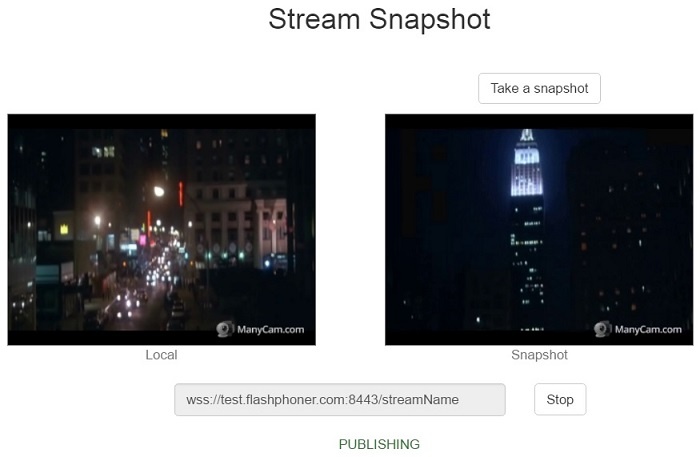| Table of Contents |
|---|
Example demonstrating how to take snapshot of a published stream at server side
This example demonstrates taking snapshot of a stream published on Web Call Server .at server side
On the screenshot below a snapshot of the stream being published has been taken.
When publishing is started, video from the camera is played in 'Local' element on the left side of the page.
When 'Take a snapshot' button is clicked, snapshot is taken and displayed in 'Snapshot' element on the right side of the page.
Code of the example
The path to the source code of the example on WCS server is:
...
Here host is the address of the WCS server.
...
Analyzing the code
To analyze the code, let's take the version of file stream-snapshot.js with hash 66cc393 ecbadc3, which is available here and and can be downloaded with corresponding build 2.0.5.28.2753.133.212.
1. Initialization of the API.
Flashphoner.init() code
| Code Block | ||||
|---|---|---|---|---|
| ||||
Flashphoner.init({flashMediaProviderSwfLocation: '../../../../media-provider.swf'}); |
2. Connection to server.
Flashphoner.createSession() code
| Code Block | ||||
|---|---|---|---|---|
| ||||
Flashphoner.createSession({urlServer: url}).on(SESSION_STATUS.ESTABLISHED, function(session){
//session connected, start streaming
startStreaming(session);
...
}).on(SESSION_STATUS.DISCONNECTED, function(){
setStatus(SESSION_STATUS.DISCONNECTED);
$('#url').prop('disabled', false);
onUnpublished();
...
}).on(SESSION_STATUS.FAILED, function(){
setStatus(SESSION_STATUS.FAILED);
$('#url').prop('disabled', false);
onUnpublished();
...
}); |
3. Receiving the event confirming successful connection
ConnectionStatusEvent ESTABLISHED ESTABLISHED code
| Code Block | ||||
|---|---|---|---|---|
| ||||
Flashphoner.createSession({urlServer: url}).on(SESSION_STATUS.ESTABLISHED, function(session){
//session connected, start streaming
startStreaming(session);
}).on(SESSION_STATUS.DISCONNECTED, function(){
...
}).on(SESSION_STATUS.FAILED, function(){
...
}); |
...
session.createStream(), publish() code
When stream is created, the following parameters are passed
...
5. Receiving the event confirming successful streaming
StreamStatusEvent PUBLISHING PUBLISHING code
| Code Block | ||||
|---|---|---|---|---|
| ||||
session.createStream({
...
}).on(STREAM_STATUS.PUBLISHING, function(publishStream){
setStatus(STREAM_STATUS.PUBLISHING);
onPublishing(publishStream);
}).on(STREAM_STATUS.UNPUBLISHED, function(){
...
}).on(STREAM_STATUS.FAILED, function(){
...
}).publish(); |
...
session.createStream(), snapshot() code
| Code Block | ||||
|---|---|---|---|---|
| ||||
session.createStream({name: name}).on(STREAM_STATUS.SNAPSHOT_COMPLETE, function(stream){
...
}).snapshot(); |
...
StreamStatusEvent SNAPSHOT_COMPLETE COMPLETE code
On receivng the event, stream.getInfo() method returns snapshot in base64 encoding. Then stream created to take snapshot is stopped.
...
8. Streaming stop
stream.stop() code
| Code Block | ||||
|---|---|---|---|---|
| ||||
function onPublishing(stream) {
$("#publishBtn").text("Stop").off('click').click(function(){
$(this).prop('disabled', true);
stream.stop();
}).prop('disabled', false);
...
} |
9. Receiving the event confirming successful streaming stop
StreamStatusEvent UNPUBLISHED UNPUBLISHED code
| Code Block | ||||
|---|---|---|---|---|
| ||||
session.createStream({
...
}).on(STREAM_STATUS.PUBLISHING, function(publishStream){
...
}).on(STREAM_STATUS.UNPUBLISHED, function(){
setStatus(STREAM_STATUS.UNPUBLISHED);
//enable start button
onUnpublished();
}).on(STREAM_STATUS.FAILED, function(){
...
}).publish();
|

